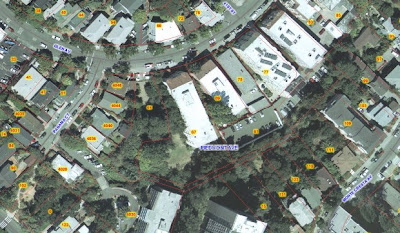Between a rock and a hard place, we find winter squash and stone fruit
Between Global Warming and Peak Oil, it is more important than ever to get the oil out of our food.
“Of all the tools for social change, the fork might just be the strongest.” Roger Dwaran
check out
http://locavores.com/
Forest Restoration Project

Behind my apartment, on the slope between Glen and Monte Cresta Avenues, is a neglected and degraded remnant parcel of land. It's severely overgrown with non-natives - Cape Ivy and Acacia trees. Despite being a marginal habitat, I've seen lots of birds and squirrels, raccoons, opossums, turkeys, and even deer in this little woods. The owners of the properties don't much care about the land (I've asked) and it's an occasional campsite for the homeless and clubhouse for no good teens. I'm trying to create a sense of place for myself here in Oakland, a connection to this landscape, and I just can't stand to see any piece of land so uncared for, so I've launched into a restoration project. I have been, when I get a chance, heading back to "the woods" to clear half-fallen Acacias and brush and clean up some trash, including a dumped couch. My idea is that if I can bring back the native trees I can later think about adding understory plants and eventually some components of a forest garden, such as a beehive or mushroom logs .
This fall I've been picking up the seeds of California Coast Live Oak, California Buckeye, California laurel, California Black Oak, Big Leaf Maple, and Madrone from locations in Oakland, Berkeley, San Anselmo, and near Olompali (8000 years of habitation! Amazing!!). Following the directions for seed propagation from the Native Plant Network, I've been soaking the seeds. Today I did the final preparation for cold stratifying (simulating cold winter dormancy) by soaking the seeds in a dilute bleach solution and packing away in perlite.
All the seeds are now sitting in the refrigerator until they sprout. Check back for updates on the project as I keep an eye on the progress of the seeds. When they're ready I'll be transplanting them into tree pots out in the garden. If you have native understory plant suggestions (or better yet some, seed to give me) let me know.
Now I have to decide what to do about that damn Cape Ivy. It's covering a huge area over several properties and if you don't get it all, it grows right back. It's a huge amount of manual labor to remove it and I just don't think I can put enough time into it to make headway against the weeds. The Golden Gate National Receation area has a a small army of volunteers working to remove it. Do I dare give it a spray with Roundup? That seems like an all out act of war on the woods. I've found a few references online to using goats to control Cape Ivy. I don't have a goat, but would be interested in borrowing one. I'm not sure what the milk might taste like when produced on a Cape Ivy diet, so I wonder if we'd have to throw the milk away while the goats are on the ivy. Any ideas?
Peak Soil- An Inconvenient Truth
Soil erosion as big a problem as global warming, say scientists
Saturday February 14, 2004
The Guardian
Erosion of topsoil - already a serious problem in Australia, China and parts of the US - threatens modern civilisation as surely as it menaced societies long since vanished, researchers warned yesterday.
Jared Diamond, a physiologist at University of California Los Angeles and author of Guns, Germs and Steel, told the AAAS yesterday that Iraq, part of the Fertile Crescent in which agriculture started 10,000 years ago, was once the wealthiest, most innovative, most advanced country in the world. But today it was a "basket case", mainly because of "soil problems, salinisation, erosion, coupled with problems of deforestation".
An area big enough to feed Europe - 300m hectares, about 10 times the size of the UK - has been so severely degraded it cannot produce food, according to UN figures.
In many places, soil is being lost far faster than it can be naturally regenerated.
Attempts to irrigate arid lands have produced soils so salty that nothing will grow.
One speaker, Ward Chesworth of the University of Guelph, Ontario, told the conference that farming had produced an "agricultural scar" on the planet that affected a third of all suitable soils.
Societies in the past had collapsed or disappeared because of soil problems. Easter Island in the Pacific was a famous example, Prof Diamond said. Ninety per cent of the people died because of deforestation, erosion and soil depletion.
"Society ended up in cannibalism, the government was overthrown and people began pulling down each other's statues, so that is pretty serious. In another example, Pitcairn and Henderson island in the south-east Pacific, everybody ended up dead. Another example was Mayan civilisation in the Yucatan peninsula of Mexico and Guatemala. Again, people survived but about 90% of the population was lost," he said.
Other examples, he said, include Iceland, where about 50% of the soil ended up in the sea. Icelandic society survived only through a drastically lower standard of living.
He said the media focused on fossil fuel problems, climate change, biodiversity, logging and forest fires, but not on the soil because it was less spectacular.
"There are about a dozen major environmental problems, all of them sufficiently serious that if we solved 11 of them and didn't solve the 12th, whatever that 12th is, any could potentially do us in," he said. "Many of them have caused collapses of societies in the past, and soil problems are one of those dozen.



